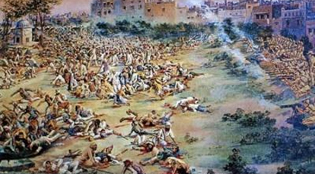Remembering Jallianwala Bagh: When Baisakhi in Punjab became a turning point in India’s struggle for freedom
By Lokmat English Desk | Updated: April 13, 2023 11:00 IST2023-04-13T10:59:25+5:302023-04-13T11:00:15+5:30
April 13, 1919, marked a turning point in the Indian freedom struggle. It was Baisakhi that day, a harvest ...

Remembering Jallianwala Bagh: When Baisakhi in Punjab became a turning point in India’s struggle for freedom
April 13, 1919, marked a turning point in the Indian freedom struggle. It was Baisakhi that day, a harvest festival popular in Punjab and parts of north India. Residents of Amritsar decided to assemble at Jallianwalla Bagh on the day to discuss the confinement of Satya Pal and Saifuddin Kitchlew, two leaders fighting for Independence and scrapping of the Rowlatt Act, which armed the British government with powers to detain any person without trial. The crowd had a mix of men, women and children and the protest was a peaceful one. The gathering included pilgrims visiting the Golden Temple who were merely passing through the park, and some who had not come to protest. Suddenly, as many as 90 British Indian Army soldiers, commanded by Colonel Reginald Dyer, appeared and without any warning to the people, ordered firing on the completely peaceful and defenseless crowd. The fusillade continued till Dyer’s ammunition ran out.
This cold-blooded carnage, Dyer admitted later, was perpetrated “to strike terror not only in the city of Amritsar, but throughout the Punjab”. The official inquiry ordered by the British government said there were 379 deaths but the Congress claimed that more than 1,000 people died in the massacre. A well, located inside the premises of the Jallianwala Bagh, stands testimony to the brutal killings of the innocent who jumped into it in panic to save themselves from the firing. 120 dead bodies were later recovered from the well. The last known survivor of the Jallianwala Bagh Massacre, Shingara Singh, died in Amritsar on June 29, 2009, at the age of 113.The massacre marks one of the most heinous political crimes committed by the Britishers during the twentieth century. It became a turning point in the history of India’s struggle for freedom. The Jallianwala Bagh site in Amritsar is now a national monument. It houses a museum, a gallery, and a number of memorial structures. The massacre caused a re-evaluation by the British Army of its military role against civilians to "minimal force whenever possible", although later British actions during the Mau Mau rebellion in the Kenya Colony have led historian Huw Bennett to comment that the new policy could be put aside. The army was retrained and developed less violent tactics for crowd control.[9] The level of casual brutality, and lack of any accountability, stunned the entire nation,[10] resulting in a wrenching loss of faith of the general Indian public in the intentions of the United Kingdom. The attack was condemned by the Secretary of State for War, Winston Churchill, as "unutterably monstrous", and in the UK House of Commons debate on 8 July 1920 Members of Parliament voted 247 to 37 against Dyer. The ineffective inquiry, together with the initial accolades for Dyer, fuelled great widespread anger against the British among the Indian populace, leading to the non-cooperation movement of 1920–22.[12] Some historians consider the episode a decisive step towards the end of British rule in India.
Open in app